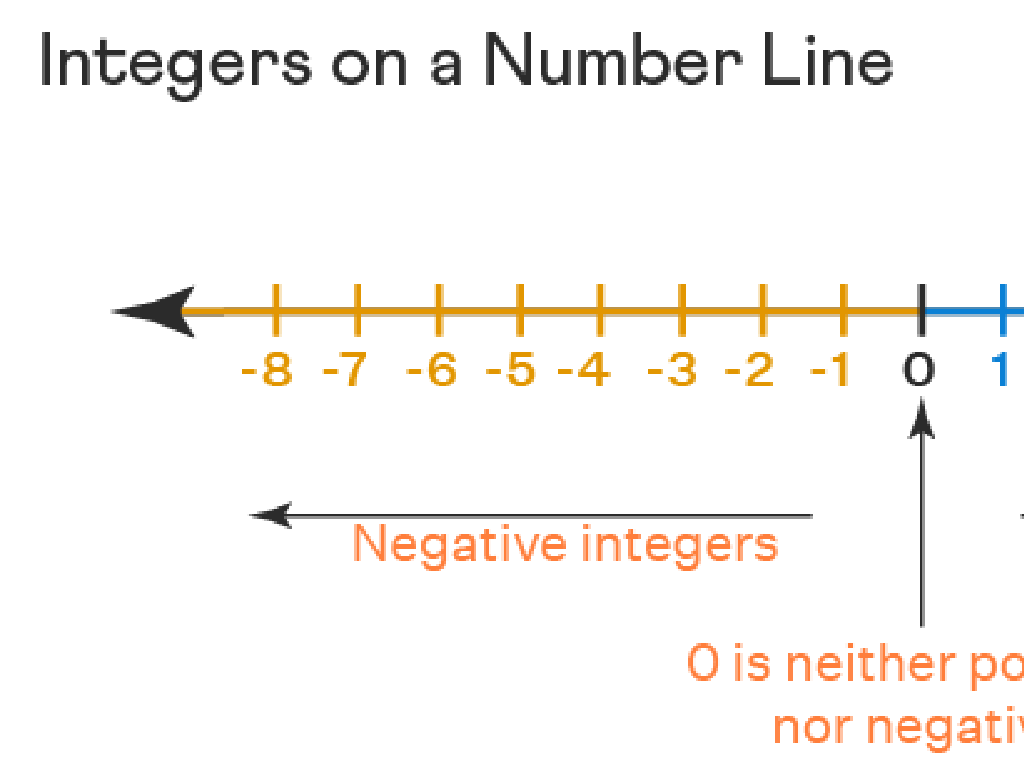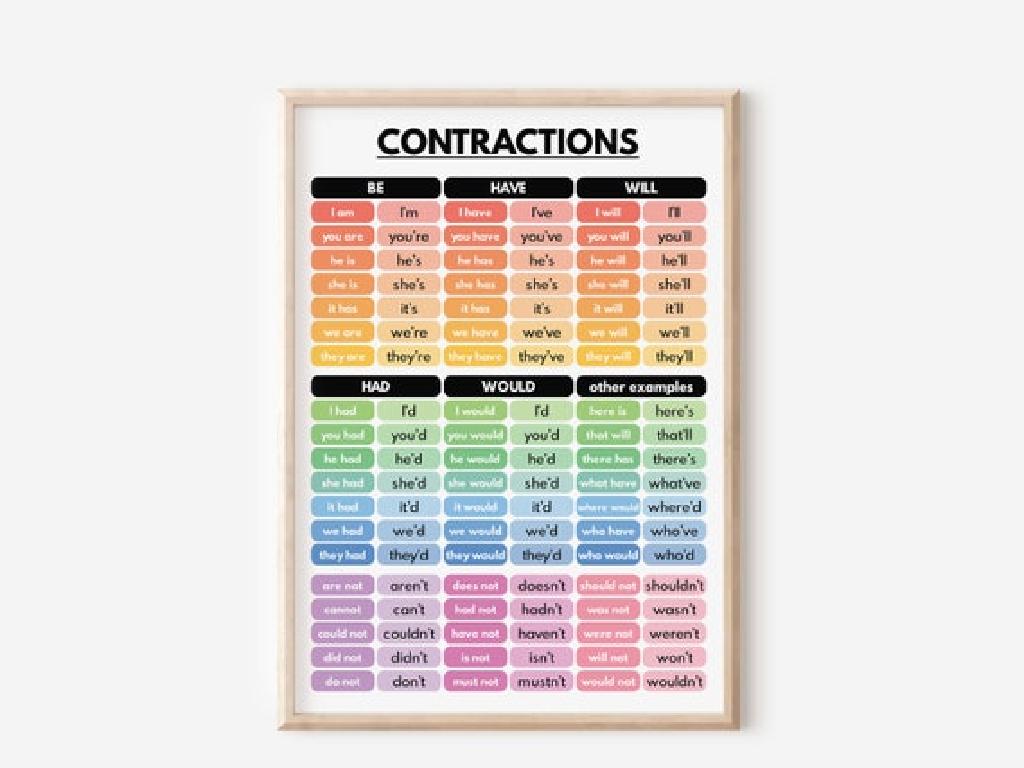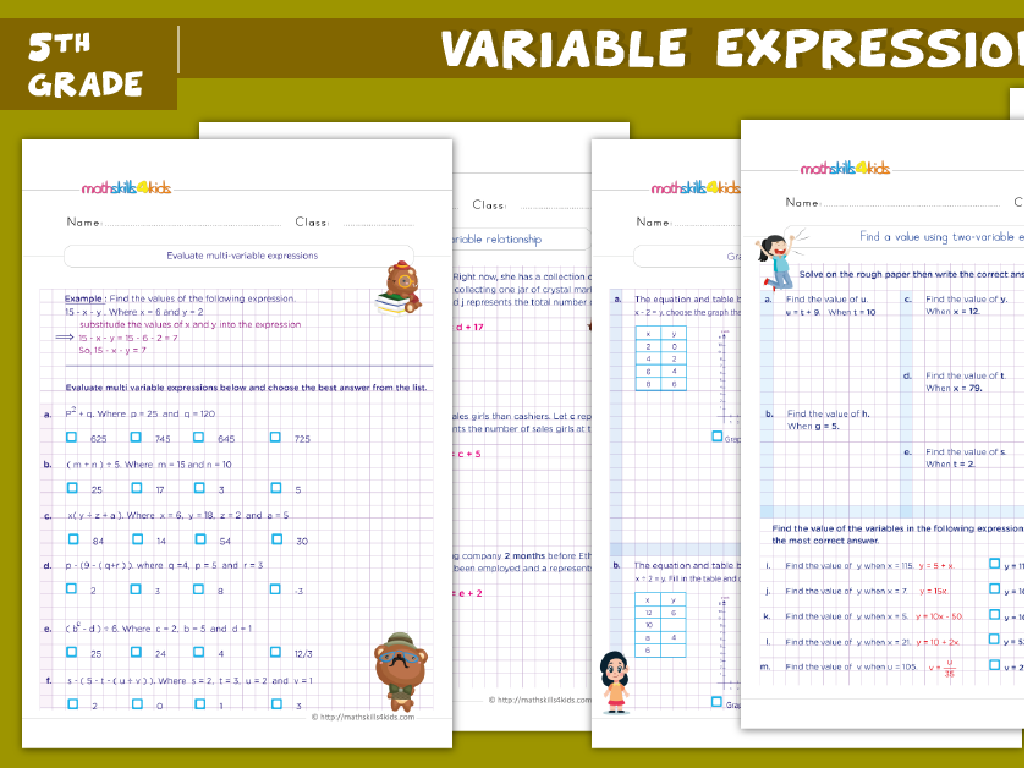Model Decimals And Fractions
Subject: Math
Grade: Fourth grade
Topic: Relate Fractions And Decimals
Please LOG IN to download the presentation. Access is available to registered users only.
View More Content
Understanding Fractions and Decimals
– What are fractions?
– Fractions represent parts of a whole, like 1/2 of a pizza.
– What are decimals?
– Decimals are another way to show parts of a whole, like 0.5 of a dollar.
– Comparing fractions and decimals
– Both represent numbers between whole numbers, but in different forms.
– Fractions and decimals in daily life
– Use them for money, measurements, and cooking recipes.
|
This slide introduces the basic concepts of fractions and decimals, aiming to help students understand that both are ways to represent numbers that are not whole. Start by explaining fractions as parts of a whole, using tangible examples like slices of pizza. Then, introduce decimals as another method to represent these parts, using money as a relatable example. Highlight the differences and similarities between the two, emphasizing that they can often represent the same value in different forms. Provide real-life examples where both fractions and decimals are used, such as in cooking (1/2 cup, 0.5 liters) or in a store with prices ($0.75, 3/4 dollars). The goal is to make students comfortable with switching between fractions and decimals and recognizing their use in everyday life.
Understanding Fractions
– Definition of a fraction
– A fraction represents a part of a whole
– Numerator and denominator
– Top number (numerator) and bottom number (denominator)
– Fractions in daily life
– Pizza slices, sharing candies, and measuring cups
|
Begin the lesson by explaining that a fraction is a way to represent a part of a whole or a division of a whole into equal parts. The numerator, which is the top number of a fraction, indicates how many parts we have. The denominator, the bottom number, tells us into how many parts the whole is divided. Use relatable examples such as dividing a pizza into slices or sharing candies among friends to illustrate the concept of fractions in a way that is tangible for fourth graders. Encourage students to think of other examples from their daily lives where fractions are used, such as in cooking with measuring cups. This will help them understand the practical applications of fractions.
Understanding Decimals
– What is a decimal?
– A number with a point that separates whole and fractional parts
– Decimal place values
– Each place after the point has a value: tenths, hundredths, thousandths
– Decimals in daily life
– Money is a common example: $0.25 means 25 cents
– Practice with examples
|
This slide introduces the concept of decimals to fourth-grade students. Begin with the definition of a decimal as a way to represent fractions and whole numbers together. Explain the place value system, emphasizing the importance of the decimal point and the value of digits to the right of it, such as tenths, hundredths, and thousandths. Use everyday examples, like money, to illustrate decimals in a context familiar to students. Encourage them to think of other examples where they encounter decimals. Conclude with practice problems to solidify their understanding, such as writing the decimal equivalent for a given fraction or identifying the value of a digit in a decimal number.
Relating Fractions to Decimals
– Convert fractions to decimals
– Divide the numerator by the denominator, e.g., 1/2 = 0.5
– Use division to relate fractions & decimals
– Understanding that dividing the top by the bottom gives us a decimal
– Practice with simple fractions
– Try converting 1/4, 3/4, and 2/5 to decimals
|
This slide introduces students to the concept of converting fractions to decimals. Start by explaining that a fraction represents a division operation: the top number (numerator) divided by the bottom number (denominator). Use simple, common fractions for practice, such as 1/2, 1/4, 3/4, and 2/5, and show how these can be easily converted to decimals through division. Provide several examples on the board and work through them as a class. Encourage students to use calculators if necessary to understand the process. The goal is for students to recognize the relationship between fractions and decimals and to become comfortable with converting between the two.
Modeling with Fractions
– Visualize fractions with models
– Use shapes like circles or bars to show parts of a whole
– Compare fractions with models
– Place different fraction models side by side to see which is larger or smaller
– Activity: Craft a fraction model
– Use materials like paper or clay to make models representing fractions
|
This slide introduces students to the concept of visualizing and comparing fractions using models, which can be shapes like circles divided into equal parts or bar models. It’s crucial for students to understand that fractions represent parts of a whole and that these parts must be equal. For the activity, provide various materials such as colored paper, clay, or blocks for students to create their own fraction models. This hands-on experience reinforces their understanding of fractions. Possible activities include creating fraction pizzas with paper, building fraction towers with blocks, or forming fraction shapes with clay. Encourage creativity and ensure that students explain their models in terms of the fractions they represent.
Modeling with Decimals
– Visualize decimals with models
– Use pictures to see what decimals look like
– Compare decimals with models
– Place decimal models side by side to see which is larger or smaller
– Base-ten block activity
– Create different decimals using blocks
|
This slide introduces students to the concept of modeling decimals, which is a visual way to understand and compare decimal numbers. Start by explaining that models can help us ‘see’ decimals, just like we visualize whole numbers. Show examples of decimal models, such as grids or number lines, to demonstrate how decimals represent parts of a whole. For comparing decimals, use models to visually demonstrate which decimals are larger or smaller by comparing the filled portions. The activity involves using base-ten blocks to build different decimal numbers, which helps students concretely understand the value of decimals. Provide a variety of blocks (hundreds, tens, ones, tenths) and ask students to represent specific decimals, like 0.3 or 1.4. This hands-on activity will reinforce their understanding of how decimals are structured and related to whole numbers.
Converting Fractions to Decimals
– Steps to convert fractions
– Divide the numerator by the denominator
– Example: Convert 1/2
– 1 divided by 2 equals 0.5
– Class practice: 3/4 to decimal
– Let’s convert 3/4 together as a class
– Understanding decimal places
– Decimals represent parts of a whole
|
This slide introduces the concept of converting fractions to decimals. Start by explaining the steps: to convert a fraction to a decimal, divide the numerator (top number) by the denominator (bottom number). Show the example of converting 1/2 into a decimal by dividing 1 by 2 to get 0.5. For class practice, guide students through converting 3/4 into a decimal. Explain that the decimal result represents the same value as the fraction, just in a different form. Emphasize the concept of decimal places and how they represent parts of a whole. Encourage students to use calculators or long division to practice this skill. Prepare additional examples for students who finish early or need extra practice.
Converting Decimals to Fractions
– Steps to convert decimals
– Example: Convert 0.75
– Write 0.75 as 75/100, then simplify to 3/4
– Class practice: 0.5 to fraction
– Let’s convert 0.5 together as a class
– Simplify fractions after conversion
– Always reduce the fraction to its simplest form
|
Begin by explaining the steps to convert a decimal to a fraction: place the decimal over 1, multiply numerator and denominator by 10 until you have a whole number, and then simplify the fraction if possible. Use 0.75 as an example, showing how it becomes 75/100, which simplifies to 3/4. For class practice, guide students to convert 0.5 to a fraction. They should write 0.5 as 5/10 and then simplify to 1/2. Emphasize the importance of simplifying fractions to their simplest form. Prepare additional examples like 0.25 and 0.125 for students who finish early or need extra practice.
Class Activity: Fraction and Decimal Bingo
– Play Bingo with math twist
– Match decimals to fractions
– Find the fraction equivalent of a called decimal
– Complete a row to win
– Have fun learning math!
|
This interactive class activity is designed to help students understand the relationship between fractions and decimals in a fun and engaging way. Prepare Bingo cards with fractions on them and call out decimals that match these fractions. Students will need to convert the decimals to fractions or vice versa to find the match on their Bingo card. The first student to complete a row wins a small prize. This game reinforces the concept of equivalent fractions and decimals. Possible variations of the activity could include using different types of fractions (like mixed numbers) or including improper fractions to challenge the students.
Wrapping Up: Fractions & Decimals
– Recap: Fractions to Decimals
– We learned how to convert fractions into decimals today.
– Why Relate Fractions & Decimals?
– Understanding this helps with math in daily life, like shopping.
– Homework: Conversion Worksheet
– Complete the worksheet to turn fractions into decimals and back.
– Practice Makes Perfect!
|
As we conclude today’s lesson, remind the students of the key concepts we’ve covered about converting fractions to decimals and the reverse. Emphasize the importance of these skills in real-world situations, such as understanding money or measuring ingredients in cooking. For homework, assign the provided worksheet which will reinforce their learning through practice. Encourage them to try their best and remind them that making mistakes is a part of learning. Offer support for any questions they may have during the next class.





